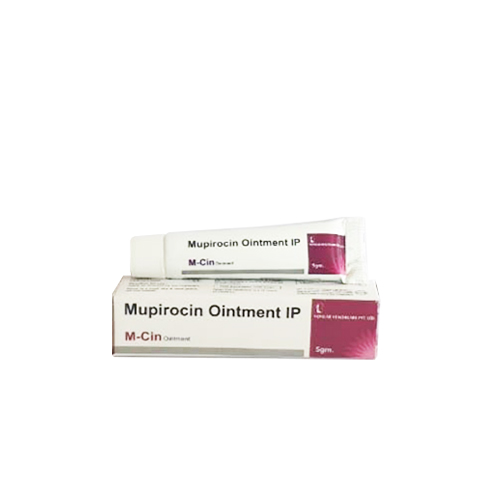- Home
- DERMA PRODUCTS
- Mupirocin Ointment

Mupirocin ointment is a topical antibiotic used to treat skin infections caused by bacteria. It works by inhibiting bacterial protein synthesis, preventing their growth and reproduction. Effective against Staphylococcus aureus and Streptococcus pyogenes, common culprits in skin infections, Mupirocin is applied directly to the affected area, promoting healing and reducing symptoms like redness and swelling. It’s crucial to follow prescribed guidelines, complete the treatment course, and avoid using it in the eyes, nose, or mouth. If symptoms persist, medical consultation is advised.
Benefits of using mupirocin ointments
Mupirocin ointment offers several benefits for treating skin infections. Its potent antibacterial properties target specific strains like Staphylococcus and Streptococcus, effectively curbing infection spread. Applied topically, it minimizes the risk of systemic side effects. Mupirocin’s localized action reduces inflammation, redness, and discomfort. Rapid healing is promoted, preventing infection escalation. Its precision in targeting bacteria makes it a preferred choice, while its minimal absorption through the skin lowers the likelihood of adverse reactions. Proper use under medical guidance ensures optimal results, aiding in quick recovery from skin infections.
How Mupirocin Ointments Works
Mupirocin ointment functions by inhibiting bacterial protein synthesis. It targets an enzyme called isoleucyl tRNA synthetase, which is crucial for bacterial cell wall synthesis. By binding to this enzyme, Mupirocin disrupts the process of adding essential amino acids to bacterial proteins, impeding their growth and reproduction. This selective action spares human cells, enhancing their safety profile. Mupirocin’s specificity in targeting certain bacteria like Staphylococcus and Streptococcus contributes to its effectiveness in treating skin infections while minimizing the risk of developing resistance.
How to use mupirocin ointments
To use Mupirocin ointment effectively, follow these steps:
- Clean and dry the affected area.
- Apply a thin layer of the ointment over the infection, covering it gently.
- Wash your hands after application to prevent the spreading of bacteria.
- Use it as prescribed by your healthcare provider, usually 2-3 times a day.
- Complete the full course even if symptoms improve.
- Avoid applying near the eyes, nose, or mouth.
- If using bandages, ensure proper ventilation.
- Inform your doctor if no improvement is seen after a few days.
Precautions while Using Mupirocin Ointment
When using Mupirocin ointment, take these precautions:
- Avoid using on eyes, nose, mouth, or open wounds.
- Inform your doctor about allergies or ongoing medications.
- Don’t share the ointment to prevent cross-contamination.
- Use as directed; excessive use lead to antibiotic resistance.
- If allergic reactions (rash, itching, swelling) occur, discontinue use and consult a doctor.
- Pregnant/breastfeeding individuals should consult a physician before use.
- Keep away from heat and direct sunlight.
- Follow proper hygiene and handwashing to minimize infection spread.
- Side effects of using mupirocin ointment
Mupirocin ointment can cause side effects, though they are rare. Common side effects include local irritation, burning, stinging, or itching at the application site. In some cases, it might lead to contact dermatitis, causing redness, swelling, and a rash. If you experience severe skin reactions, like blistering or crusting, or systemic symptoms such as fever, inform your healthcare provider immediately. While uncommon, serious allergic reactions can occur; watch for symptoms like difficulty breathing or swelling of the face, lips, or throat. If any adverse reactions emerge, discontinue use and seek medical attention promptly.
Related products
We are a research-based pharmaceutical company. The mission of Novalab Healthcare is to improve the health of the Indian community by providing them with quality
Quick Links
Location
- Plot No-208, Industrial Area Phase 1, Panchkula, Haryana 134113
- Novalab7777@gmail.com
- +91-9570599567
- +91-9115604598





